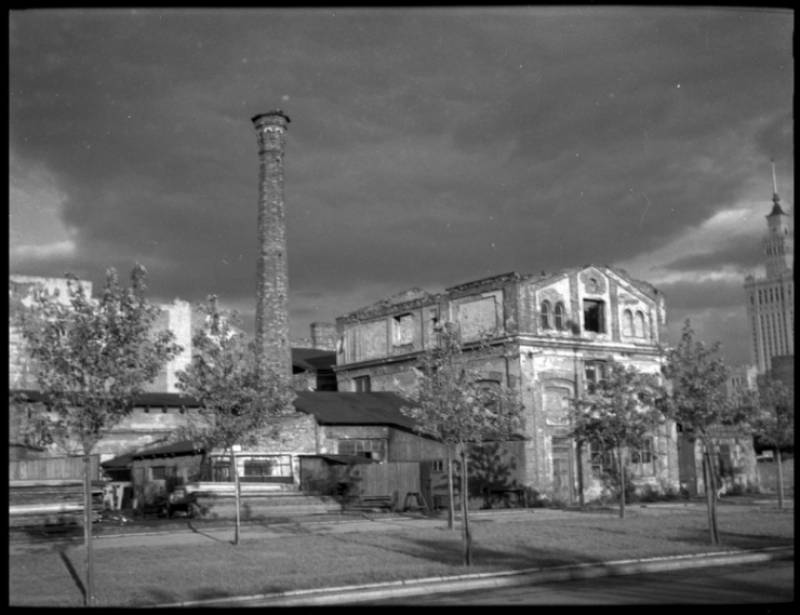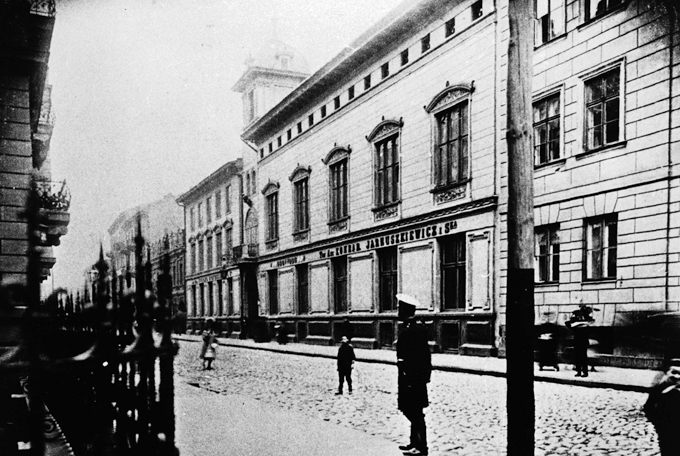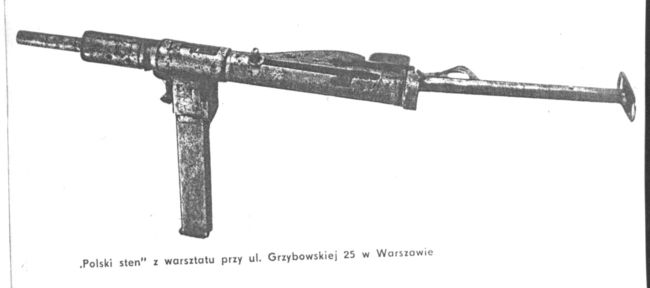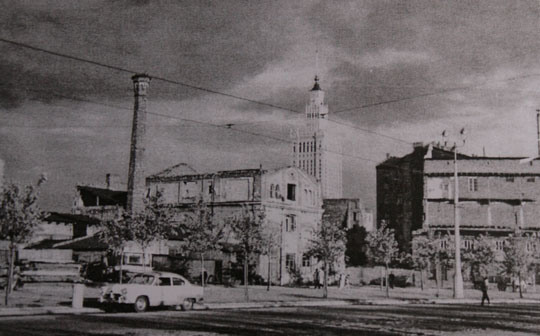

Hotel Mercure does not exist anymore but it was on its wall that one could see a modest board commemorating the events which took place nearly 70 years ago, right where these days the Q22 building site can be found.

During World War II, there was a factory here, founded at the beginning of the 20th century, which belonged to the "Konrad, Jarnuszkiewicz i S-ka" Metalwork Joint-Stock Company.
It was a big enterprise, with around 800 employees, 15 buildings and nearly 300 machines, producing an impressive range of goods: office furniture, filing cabinets for offices and archives, metal tube furniture, bus and plane seats, wardrobes for workers, barrack beds, tourist and bunk beds, military and railway stretchers as well as those for ambulances, cloak hangers for sanatoriums, hotels, theatres and restaurants, beds and extensive apparatuses, mechanical wheelchairs, single beds with cases for the bedding, furnishing for surgeries, levers and baggage trolleys. In the catalogue, the factory advertised itself as the First Special Bed and Hospital Furniture Company in Warsaw. In 1939 the factory was badly damaged. It did not, however, stop the production during the war. 
In 1940 the factory on Grzybowska Street (the street today known as Al. Jana Pawła did not exist as yet) became part of the Jewish Ghetto. In 1943, one of its employees Józef Kapler aka "Jutkiewicz" started an illegal production of machine guns destined for the Polish underground, modelled after the English construction.
Kapler was a talented constructor, great organiser and a Home Army soldier. He came across the authentic multi-shot guns called stens, which had been dumped from a plane, during training for Home Army soldiers in covertly operating schools for officer cadets. "Jutkiewicz" spotted with his talented eye of a gunsmith that, after a few alterations, the guns might be covertly produced in a greater number to satisfy the needs of the Home Army.
In Konrad and Jarnuszkiewicz"s factory, Kapler was the head of a factory fire brigade, formed by Germans. Its members spent every third night in the factory and, thanks to special badges on their caps, they could freely move around occupied Warsaw, despite the curfew. It was during those fire brigade nightshifts that the parts for Polish sten guns were made. "Jutkiewicz" was a talented organiser and his talent was brilliantly described by Grażyna Dziedzińska in her article "Polish Sten Guns from a Nazi Factory", published by the Nasz Dziennik daily:
„Kapler invented ways of hiding what he was actually doing and concealing the losses in the warehouse. He also constructed elements of this gun from ready-to-use materials applied in the factory which were delivered by... Germans. It related, for instance, to the bodies of Polish sten guns, which were made from hydraulic cylinders officially produced for levers in operating tables for Germans.
Soldiers of the underground stole barrels for Polish multi-shot handguns from the "Gerlach" factory, where the barrels were produced before the war. Then they were delivered to "Jutkiewicz". In the factory on Grzybowska, the barrels were cut into three parts, because sten guns had shorter barrels. They also had to be re-calibrated from a 6.35 mm to a 9 mm diameter. "Jutkiewicz" also constructed screwing machines for the barrels. The successful production of the Polish sten gun made it possible for Bronisław Jastrzębski aka "Damazy" to receive Kedyw"s approval for financing the current production and the delivery of appropriate material for the barrels and breech blocks, providing that the produced Polish sten guns would be at Kedyw"s disposal. "Damazy" acted as an intermediary in organisational and financial matters of the leaders of Kedyw KG AK. Lieutenant Tadeusz Gwiazdecki aka "Mechanik", a representative of Kedyw KG AK, was in turn responsible for the collection and technical control of the sten guns and materials for the barrels. He delivered ammunition and magazines, frequently seized from Germans by partisans dressed as Nazi soldiers, and directly managed the production of sten guns in Jarnuszkiewicz"s factory.
Captain Józef Kapler says: “It must be added that there was a dead drop at Towarowa 30. Mrs Jadwiga Hołubek lived there. Her husband worked for the Weapons Factory in Radom and her father-in-law was a deputy police leader in Radom. Michał Doliński, her father, a soldier in the legion of Piłsudski, died due to injuries. The dead drop at Towarowa proved to be useful and necessary for the sten gun production. As soon as we had more sten guns, my deputy Henryk Wilk aka "Stal" notified "Mechanik", and invited him to check and approve the produced machine guns. Everything was strictly registered. Lieutenant Gwiazdecki contacted colonel "Radosław" and decided where and when the couriers, including Róża Mieszczanek aka "Barbara", secretary in Konarski Professional College, a permanent courier between "Mechanik" and the Jarnuszkiewicz"s factory, among others, could collect sten machine guns assigned for the divisions "Baszta", "Narocz", "Zośka" and "Parasol". The collection was organised in such a way that the couriers could not work out where the production of the Polish sten guns was done.” […]
December 1943 saw the beginning of the batch production, based on the produced and completed tooling. The date of birth of the Polish sten gun in Jarnuszkiewicz"s factory - December 1943 – was imprinted near the eagle. Where did the eagle come from? Well, Józef Kapler hid a seal with an emblem of the eagle and WP letters which was previously used for money boxes produced for the army before the war in Jarnuszkiewicz"s factory. They came in very handy when the production of the sten guns started. The eagle, WP and pm letters were imprinted on one side of the magazine inlet, and the serial number on the other. 
The weapons warehouse belonging to "Narocz" group, which temporarily was part of "Radosław" group during the Warsaw Uprising, was located at Mokotowska 36. Sub-Scoutmaster Edmund Szaniawski aka "Zbigniew", a member of Gray Ranks, was the warehouse manager. He carried a false id in the name of a Hungarian, Edmund Szechenyi. For this reason, as a foreigner and an "ally" of the Germans, he had his room protected in the doorway by the sign of the Accommodation Office (Wohnungsamt). "Zbigniew" and his roommate Andrzej Gawecki aka "Sław" shot with the delivered sten guns from the roof of the house where they lived (!). How was that possible? Numerous Germans from the administration of the General Government were accommodated in the house. During air raids, they were shooting at planes which were flying low. At the same time, "Zbigniew" and "Sław" were shooting the sten guns, checking whether they did not jam, whether they shot continuously or with a single shot, etc.
187 sten guns had been produced before the Warsaw Uprising started. As confirmed by the experts and the users of the Polish sten guns, including "Zbigniew", the gun proved to be excellent in street fights. Its effective range was accurate to 500 m; the magazine contained 32 9mm calibre bullets.
In August 1944, the factory on Grzybowska Street was taken over by the insurgents. The factory had its own sources of power and water, which was extremely important for the fighters. They built a barricade on Grzybowska Street preventing the Germans from entering the Śródmieście district.
![]()
![]()
During the Warsaw Uprising, nearly 90% of the factory buildings were destroyed. Its employees attempted at reconstructing the factory and, partially succeeded, although their efforts were hasty and lacked precision. In 1948, however, the factory was nationalised. It survived until the end of the 1950s, when, in connection with the construction of Julian Marchlewski Street, presently known as Al. Jana Pawła II, its remnants were demolished. 
![]()
In 1993 Hotel Mercure "Fryderyk Chopin" was built in lieu of the former factory "Konrad, Jarnuszkiewicz i S – ka". However, the hotel failed to become part of the Warsaw landscape and, after less than 20 years, it was replaced by new architectonic and functional quality. ![]()